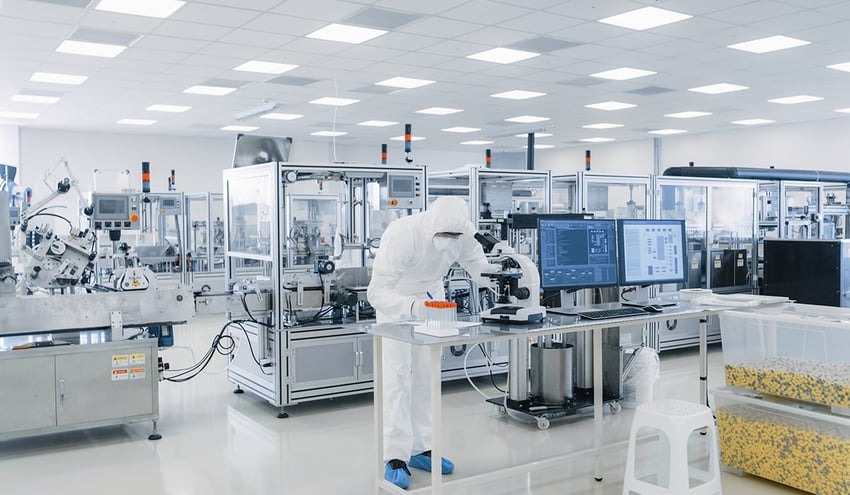The Definitive Guide for Professionals, Researchers, and Entrepreneurs
Introduction
A medical robotics laboratory is at the forefront of healthcare innovation, research, and industrial transformation. As medical robotics becomes instrumental in surgery, diagnostics, rehabilitation, and clinical automation, the need for advanced labs has never been more pressing. Whether you’re a professional, researcher, or business owner, strategically establishing a medical robotics lab is a high-impact investment that requires technical insight, regulatory acumen, and a well-crafted business plan. This comprehensive guide explores every aspect of medical robotics lab setup—from infrastructure and essential equipment to regulatory compliance, workflow, business strategy, and emerging trends. Throughout, you’ll find friendly keywords such as medical robotics lab setup, medical robotics equipment, medical robotics business plan, robotic surgery lab, robotics research lab, and medical device testing lab for optimal search visibility.

What is a Medical Robotics Lab?
A medical robotics lab is a specialized facility where engineers, clinicians, and scientists design, test, and validate robotic systems for medical, research, industrial, or educational applications. From surgical robots to laboratory automation platforms and assistive robots in rehabilitation, these labs enable the innovation, testing, and safe deployment of robotic solutions in healthcare and allied fields.
Key Functions of a Medical Robotics Laboratory
- Clinical Research & Product Development: Prototyping, refining, and testing new surgical or assistive robots.
- Regulatory Testing: Ensuring devices meet safety, efficacy, and performance standards.
- Training & Education: Hands-on experience for surgeons, students, and healthcare professionals.
- Industry Collaboration: Supporting device manufacturers and startups with R&D and quality control.
- Diagnostics & Automation: Developing robots for automated diagnostics, sample handling, or hospital logistics.
SEO Keywords: medical robotics innovation, robotics R&D, robotic device validation, healthcare robotics training.
Step 1: Define Your Lab’s Purpose and Market Focus
Before setting up a medical robotics laboratory, establish your primary objectives:
- Surgical/Clinical Robotics: Focus on design, prototyping, and testing of minimally invasive surgery systems, telemedicine robots, or rehabilitation devices.
- Research Robotics: Target robotics for biomedicine, AI integrations, and interdisciplinary research.
- Industrial/Quality Control: Validate robotic components, automate device testing, or develop new manufacturing solutions.
- Educational/Training: Equip the next generation of professionals with hands-on skills in medical robotics and allied technologies.
Clarify your vision to inform the infrastructure, equipment, regulatory needs, and market strategy of your lab.
Step 2: Market Analysis and Business Planning
1. Target Audience:
- Hospitals and surgical centers
- Research institutes and universities
- Robotics and medical device manufacturers
- Government agencies and public health bodies
2. Opportunity Mapping:
- Study regional and global trends in medical robotics lab setup.
- Identify existing labs, their capabilities, and services.
- Find gaps: e.g., rapid prototyping, regulatory pre-testing, training modules, or technology transfer.
3. Competitive Analysis:
- Analyze successful labs and their unique selling points.
- Benchmark your offerings for specialized domains: robotic surgery, automated diagnostics, wearable health robotics, etc.
4. Financial Planning:
- Factor in high startup costs (infrastructure, robotics platforms, licenses).
- Develop a multi-pronged revenue model: contract research, training, device certifications, and collaborative grants.
- Prepare detailed financial projections to attract grants, investors, or academic partnerships.
SEO Keywords: medical robotics business plan, robotics lab ROI, robotics market analysis, lab funding strategies.
Step 3: Infrastructure, Facility, and Lab Design
A. Location
- Proximity to medical centers, academic institutions, or industrial clusters.
- Ease of access for collaborators, clients, and regulatory authorities.
B. Space Allocation
- Robotics development and assembly zone
- Programming and simulation workstations
- Wet labs (for device interaction with biological materials)
- Prototyping and fabrication (3D printing, CNC machining)
- Training theater/classroom
- Secure storage for hazardous materials and sensitive components
- Administrative and discussion rooms
C. Environmental Controls
- Controlled temperature, humidity for sensitive equipment
- Electrostatic discharge protection for electronics
- Fire and occupational safety features
SEO Keywords: medical robotics lab design, robotics workspace planning, robotics infrastructure, safe lab design.
Step 4: Essential Medical Robotics Lab Equipment
A standard medical robotics lab combines high-tech robotics platforms, precision tools, and advanced computing. Below are the core essentials:
| Equipment | Function/Use |
|---|---|
| Surgical/Assistive Robots | Design, prototyping, and testing |
| Robotic Manipulators/Arms | Precision control and surgical simulation |
| Haptic Feedback Devices | Realistic training and control development |
| Microcontrollers/Boards | Electronics prototyping (Arduino, Raspberry Pi) |
| 3D Printer & CNC Machines | Custom prosthetics, model fabrication |
| Motion Capture Systems | Tracking robot/human motion for testing |
| Biomechanical Sensors | Feedback in wearables and exoskeletons |
| Imaging Modules (Cameras, LiDAR) | Navigation, targeting, and visual feedback |
| Prosthetic/Orthotic Devices | Wearable biomechanics research |
| Simulation and VR Platforms | Surgical rehearsal, device testing |
| Analytical Tools (Mass Spec, GC) | For contamination and material testing |
| Force/Torque Sensors | Device feedback and validation |
| Computers/High-end Workstations | Programming, AI training, and data analysis |
| LIMS/Robotics Suite Software | Data management and robotic control |
| Biosafety Cabinets & PPE | Safety with biological samples |
SEO Keywords: medical robotics lab equipment, surgical robot platform, 3D printing medical devices, lab sensors for robotics, simulation software for robots.
Step 5: Laboratory Workflow, Layout, and Zoning
A. Zoning and Layout
- Development Zone: Robotics assembly, mechanical, and electrical prototyping.
- Simulation/Testing Zone: Virtual reality simulators, accuracy and safety validation.
- Programming Zone: High-performance computers for code development and AI/ML training.
- Cleanroom/Wet Lab: For biocompatibility, sterility, and device-environment interface work.
- Training/Classroom: Dedicated area for professional education or live demos.
B. Workflow Optimization
- Ensure unidirectional sample flow to minimize cross-contamination.
- Use barcode/LIMS-enabled tracking for all prototypes, samples, and data.
- Automate repetitive testing through software-controlled robotic arms and sensors.
- Segregate high-risk or experimental devices from demonstration/teaching areas.
SEO Keywords: robotics lab workflow, robotics lab layout, automation in robotics lab, lab sample tracking.
Step 6: Staffing and Training
Key Lab Roles:
- Lab Director/Manager: Oversees compliance, strategy, and business growth.
- Robotics Engineers: Lead robotic design, integration, and system control.
- Medical Device Specialists: Ensure compatibility with clinical protocols and standards.
- Software Developers/AI Experts: Build control systems, AI modules, and machine learning pipelines.
- Research/Clinical Coordinators: Bridge biomedical and engineering requirements.
- Quality Assurance and Compliance Officers: Maintain standards, manage documentation, and regulatory audits.
- Lab Technicians/Assistants: Support assembly, testing, and maintenance.
- Administrative Staff: Handle billing, procurement, data management.
Training Focus:
- Robotic system safety and operation
- Advanced programming and machine learning
- Medical device standards (ISO 13485, IEC 60601)
- Quality management, record-keeping, and disaster recovery.
SEO Keywords: robotics lab staffing, robotics technician skills, robotics research jobs, lab training programs.
Step 7: Regulatory, Ethics, and Accreditation
A. Regulatory Compliance
- Adhere to national/international medical device regulations (e.g., FDA, CE Mark, CDSCO India).
- Conform to ISO 13485, ISO 17025, ISO 10993 for medical device development and testing.
- Implement Good Laboratory Practice (GLP) and Good Manufacturing Practice (GMP) as relevant.
B. Safety and Biosafety
- Biosafety protocols for any biological or clinical experimentation.
- Chemical safety for solvents, lubricants, and device sterilants.
- Fire safety and occupational hazard training for all equipment users.
- Regular safety drills, incident documentation, and corrective action workflows.
C. Accreditation
- Obtain NABL/NABH/ISO accreditations according to the services offered.
- Maintain an auditable Quality Management System (QMS) and Standard Operating Procedures (SOPs).
SEO Keywords: robotics lab accreditation, medical device compliance, safety protocols for robotics lab, ISO for robotics.
Step 8: Business Model and Revenue Streams
| Revenue Source | Details |
|---|---|
| Contract Research & Testing | Device validation, performance testing, regulatory pre-approval |
| Training & Certification | Courses for professionals, students, and clinicians |
| Collaborative Grants/Projects | Partnerships with industry, academia, and government |
| Device Prototyping and Technology Transfer | Spin-offs, patents, licensing |
| Consulting and Quality Assurance Services | Product development, regulatory documentation, compliance |
- Identify your lab’s monetization opportunities early.
- Use a blend of consultative and service-based models.
SEO Keywords: medical robotics business plan, lab revenue streams, device testing contracts, robotics commercialization.
Step 9: Marketing and Growth Strategies
- Launch an SEO-optimized website showcasing lab capabilities, compliance, and certifications.
- Network with hospitals, device manufacturers, research bodies, and funding agencies.
- Promote successful projects or scientific publications in medical robotics.
- Organize seminars, workshops, and open days—positioning your lab as a knowledge hub.
- Invest in innovation and IP management for new robotics technology.
SEO Keywords: robotics lab marketing, medtech lab strategies, robotics lab networking, tech transfer in robotics.
Step 10: Trends and Innovation in Medical Robotics
- AI-driven Robotics: Integration of computer vision, machine learning, and robotics for smarter diagnosis and surgical assistance.
- Remote and Teleoperated Surgery: Enabling access to advanced care in remote regions.
- Miniaturization & Wearable Robots: Biomedical exoskeletons, ingestible robots, and micro-surgical tools.
- Lab Automation: From sample analysis to pharmacy robots improving hospital logistics.
- Surgical Simulation & VR: Virtual reality platforms for surgical rehearsals and skills assessment.
- Green Robotics: Energy-efficient devices and sustainable lab operations.
SEO Keywords: AI medical robotics, telemedicine robotics, wearable medical robots, medical robotics trends, lab automation.
Step 11: Implementation Checklist
- Clarify lab scope and target market
- Conduct thorough market analysis and business planning
- Secure startup funding and location
- Procure robotics platforms, instruments, and software
- Design compliant facility layout and safety systems
- Recruit multidisciplinary and certified team
- Develop SOPs and implement quality management
- Complete regulatory certifications and accreditations
- Launch digital marketing and outreach campaigns
- Continuously upgrade capability and innovate
Keywords: robotics lab setup checklist, lab implementation guide, robotics lab accreditation, startup planning.
Conclusion
Setting up a medical robotics lab is an ambitious but rewarding journey that combines cutting-edge engineering, clinical science, regulatory expertise, and entrepreneurial strategy. By following this guide and remaining proactive about emerging trends, compliance standards, and user demand, your facility can drive innovation in patient care, medical training, research, and industrial quality assurance.
This comprehensive blueprint applies to medical robotics labs in hospitals, industry, research, and educational institutions worldwide. For region-specific guidelines, liaise with local authorities, healthcare bodies, and accredited robotics associations.
Keywords Used
- medical robotics lab setup
- medical robotics equipment
- medical robotics business plan
- robotic surgery lab
- robotics research lab
- medical device testing lab
- robotics training
- medical device compliance
- ISO for robotics
- robotics lab accreditation
- robotics lab marketing
- robotics lab workflow
- robotics lab safety
- laboratory automation



